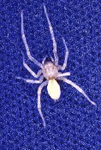 The yellow (golden) sac spiders, genus Cheiracanthium are members of the spider family Clubionidae (sac spiders): Members of this family build a sack-like, silken tube in foliage or under bark or stones as their lair. In nature Cheiracanthium species are usually found in foliage, but some species are found inside houses and around other human developments. These spiders are relatively small (10 mm body length), and are yellowish in color; they are difficult to distinguish from one another, and species identification requires examination by an arachnologist.
The yellow (golden) sac spiders, genus Cheiracanthium are members of the spider family Clubionidae (sac spiders): Members of this family build a sack-like, silken tube in foliage or under bark or stones as their lair. In nature Cheiracanthium species are usually found in foliage, but some species are found inside houses and around other human developments. These spiders are relatively small (10 mm body length), and are yellowish in color; they are difficult to distinguish from one another, and species identification requires examination by an arachnologist.
- Yellow sac spiders are among the least known clinically significant spiders, but they are indeed capable of causing a painful bite with development of a necrotic lesion (not as severe as the brown recluse or hobo), and can sometimes produce systemic effects as well. They are very prone to bite defensively (more so than any other significantly venomous U.S. spider), and some bites in humans have occurred in unusual places, such as in automobiles and swimming pools. It is likely that many U.S. cases of necrotic arachnidism ascribed to the brown recluse spider outside of its natural range, are actually yellow sac spider bites
- Yellow sac spiders which have been implicted in human poisonings include C. brevicalcaratum in Australia, C. inclusum in the United States and southwestern Canada, C. japonicum in Japan, C. mildei in the Mediterranean and the United States, C. mordax in Australia, the Central and Southwestern Pacific, and some parts of the United States (including Hawaii), and C. punctorium in Europe. In the United States inclusum (indigenous) and mildei (introduced) are the species most likely to be found, and the most likely to produce bites: These two spiders have a wide distribution in the United States, and precise ranges for them have not been defined. They tend to be transported easily, particularly in agricultural products such as grapes; in some areas (such as southeastern Idaho), it appears that grocery store grapes shipped from vineyards in central California are a principal means of introduction.
- Cheiracanthium mildei was first identified as a cause of necrotic arachnidism in 1970, when it was linked with skin lesions in the Boston, Massachusetts area (where it is the most common spider found in houses); it is also common in houses in New York City, and may well be the cause of recent "brown recluse bite" rumors circulating there. In the late 1970's and early 1980's mildei produced a significant number of bites in the Provo, Utah area. C. inclusum has been reported responsible for bites in Georgia and southwestern Canada; bites by this species are probably far more common and widespread than this however, and it is likely that more reports will surface as Cheiracanthium species become better known as clinically significant spiders.
- Bites by yellow sac spiders generally produce instant, intense stinging pain, not unlike that of the sting of a wasp or hornet. This may be followed by localized redness, swelling and itching; these manifestations may or may not evolve into a necrotic lesion, but when that occurs healing is usually complete within eight weeks. Systemic effects are usually not severe, but when they occur may include chills, fever, headache, dizziness, nausea, anorexia, and sometimes shock. Treatment for the local lesion should follow the same protocols as outlined for the hobo and brown recluse spiders: Likewise, corticosteroid therapy may be beneficial when systemic effects are present.